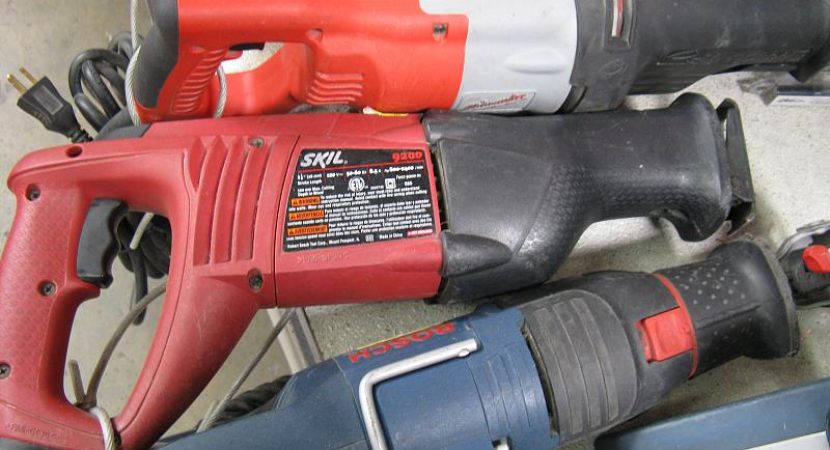Last Updated on
There’s no doubt as to whether you’re familiar with power saws, it’s one of those tools nearly everyone has used at some point. But if you’re coming across this term for the first time don’t fret; a power saw is a plumbing tool that’s used for cutting work-pieces. This is especially the case with wooden pieces.
A reciprocating saw is a more advanced and evolved predecessor of the power saw. These incredibly powerful and versatile saws come in handy when you need to tear or cut off something. As an essential tool, it has tons of uses across a wide range of areas.
Here’s a handy guide for reciprocating saws by HandyToolsHome.com.
What Is A Reciprocating Saw?
The term itself gives you a hint on how this saw works. The term “reciprocating” alludes to the blade’s movement. Remember the handheld power saw, now, in this case, the blade does all the work; all the user has to do is to hold the saw in place. The blade sticks out of the front and moves back and forth.
As an advanced version of the power saw, the reciprocating saw facilitates angular and precise cuts, even when you’re cutting large pieces.
History of the Reciprocating Saw
You’ve probably come across a hack saw, or maybe you have one in your garage. Since back in the day, the hack saw has been used by home builders, contractors, and even plumbers. However, as electricity started powering tools the Milwaukee Electric Tool Co. designed a right angle saw.
This saw was similar to the reciprocating saws. The only difference is that the blade was facing down. Ideally, the tool was used by plumbers. Fast forward, manufacturers created the innovative reciprocating saw with the sole intent of matching the changing demands. The saw became very popular due to its capabilities and durability.
Types of Reciprocating Saws
The main difference between reciprocating saws is how they’re powered and their size.
Cordless Vs. Corded
Cordless saws use a battery. This makes them very convenient.
On the other hand, corded saws need a power source for them to operate.
How Best To Use Reciprocating Saws
You cannot talk about versatile tools and forget to mention the reciprocating saw. They’re ideal for a broad range of uses which include:
- Wall Indentation – If you need to make indentations on the wall, then this is the tool for that job. This is especially the case when you have to make cuts involving odd angles.
- Installing PVC Piping – If you need to modify the piping in your house, this tool will come in handy. It will help you cut out different angles, which could be challenging if you’re using other types of saws.
- Cutting Nails – If you come across stubborn nails that are hard to remove, this is the way to go. The reciprocating saw will help you cut out these nails.
- HVAC and Plumbing – Due to their ability in maneuvering tight spaces they work effectively when used for plumbing purposes. There’s no need to move the saw around, you just press the trigger and cut those pipes down.
- Fitting Windows – Ask any plumber, and they’ll tell you how frustrating this job can be. You need to be precise when fitting windows. That’s why you need this tool to trim off the frame area.
- Construction – There’s a lot that goes on in construction. However, during demolition, you need this tool. It helps plumbers tear down studs, make precise cuts, remove walls and make other crucial cuts. The tool is convenient, quick and effective.
- In emergency rescue – The blade does a great job of making crude cuts when people need to access something or someone. For instance, during a car accident, you might have to cut out the wreck to save lives.
- For Yardwork – You can use this tool to cut down trees, metallic objects or even wooden pieces. Basically, anything that needs to be cut or trimmed.
Parts of a Reciprocating Saw
Using a reciprocating saw is not that complex. However, you need to get an understanding of how the main components and parts work.
- Blade – This is the part that cuts. There are different materials, teeth designs, and sizes. You can easily change the blade if need be.
- Shoe –This part controls the blade movement. However, it can be adjusted depending on your needs.
- Blade Clamp –This part holds the blade in position.
- Trigger –This part activates the blade’s movement and speed.
- Power button/source -This is where the battery is located or the connecting cord.
- Grip – This is where you hold with your second hand as you operate the saw.
How To Use A Reciprocating Saw?
By now, you have an idea of how this versatile tool works. It’s fairly easy. Here’s how to go about it:
1st step: Choose the type of blade you need. Having identified the kind of material you’ll be cutting, you’re in a better position to select the right blade for the job.
2nd step: Mount the blade. It’s very simple; insert the back end of the blade and ensure it’s secured. Firmly place the blade using the blade clamp to ensure it’s secure.
3rd Step: Adjust the shoe. This is very important, especially if you’ll be cutting hard materials.
4th Step: Press the Trigger. Now its time to activate the blade by pressing the trigger. Whatever you’re cutting just make sure you start slowly and increase the speed gradually.
5th Step: Cut the material. It’s important for you to make sure you’re applying even pressure as you cut. This will give you more control and a precise cut.


Reply